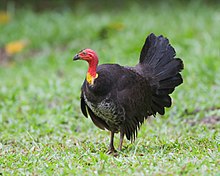Galloanserae
| Galloanserans Temporal range: Early Cretaceous – Holocene, 105–0 Ma |
|
|---|---|
 |
|
| Australian brushturkey (Alectura lathami) | |
| Scientific classification | |
| Kingdom: | Animalia |
| Phylum: | Chordata |
| Clade: | Ornithurae |
| Class: | Aves |
| Infraclass: | Neognathae |
| Superorder: |
Galloanserae Sclater, 1880 |
| subgroups | |
Fowl are birds belonging to one of two biological orders, namely the gamefowl or landfowl (Galliformes) and the waterfowl (Anseriformes). Studies of anatomical and molecular similarities suggest these two groups are close evolutionary relatives; together, they form the fowl clade which is scientifically known as Galloanserae (initially termed Galloanseri). This clade is also supported by morphological and DNA sequence data as well as retrotransposon presence/absence data.
As opposed to "fowl", "poultry" is a term for any kind of domesticated bird or bird captive-raised for meat, eggs, or feathers; ostriches, for example, are sometimes kept as poultry, but are neither gamefowl nor waterfowl. In colloquial speech, however, the term "fowl" is often used near-synonymously with "poultry," and many languages do not distinguish between "poultry" and "fowl". Nonetheless, the fact that the Galliformes and Anseriformes most likely form a monophyletic group makes a distinction between "fowl" and "poultry" warranted.
The historic difference is due to the Germanic/Latin split word pairs characteristic of Middle English; the word 'fowl' is of Germanic origin (cf. Old English "fugol", Dutch vogel, German Vogel, Swedish fågel, Danish/Norwegian fugl), whilst 'poultry' is of Latin via Norman French origin.
Many birds that are eaten by humans are fowl, including poultry such as chickens or turkeys, game birds such as pheasants or partridges, other wildfowl like guineafowl or peafowl, and waterfowl such as ducks or geese.
...
Wikipedia
